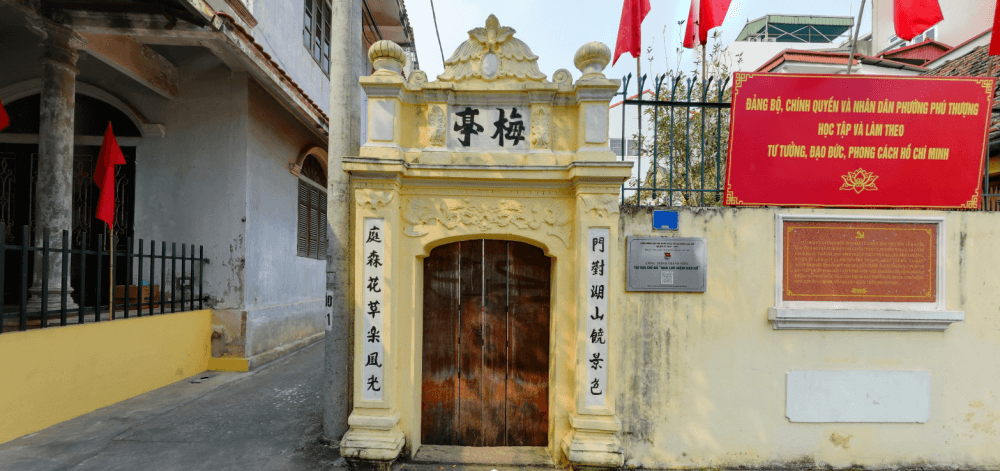

Introduce
Phu Thuong is an ancient area of Tu Liem district, now is Phu Thuong ward, Tay Ho district, consisting of 3 residential clusters: Phu Gia, Phu Xa and Thuong Thuy. Over the years of hard work, the Phu Thuong people built their own village, creating a land of ancient culture in this land. In the text "Ap ton than su tich", as well as many documents, ancient tablet have recorded that cultural tradition. To this day, ancient pagodas, temples such as Phu Gia Pagoda, Phu Xa Pagoda, Thuong Thuy temple are still preserved bearing local cultural identity.
Previously in Phu Thuong, there was a boat pier with people traveling and trading on the river. Recognizing Phu Thuong as a strategically important position, convenient transportation, ministries, follow the direction of General Secretary Truong Chinh is: "Certainly the cause of the Party and the national salvation base is to be concentrated in the areas where workers are concentrated, the strategic roads"; The Central Task Force has set up many revolutionary bases. With a resilient tradition against foreign invaders, and receiving revolutionary spirit from the public newspaper of the Party such as "Tin Tuc", Phu Thuong became an important venue in the security zone of the headquarters. This is to protect senior Party leaders working in secret.
Thus, thanks to favorable transportation conditions, with a passionate patriotism and a revolutionary spirit, Phu Thuong was chosen as the basis of the Party Central Committee's pre- uprising 1941 - 1945.
Among the revolutionary establishments built during this period, there was Mrs. Hai Ve’s house in Phu Gia. This is also the longest working place of the Central Committee of the Indochinese Communist Party, now the Communist Party of Vietnam.
In the period from 1941 to 1945, comrades Truong Chinh, Hoang Van Thu and many other revolutionaries lived and worked here. Mrs. Hai Ve's house next to the Red River dyke. Mrs. Hai Ve made silkworm mulberry cultivation so few people come to play because of abstinence, fearing silkworms will die. Her brother, Pho Phan, soon became enlightened, so it was a good idea to arrange for the members of the Standing Committee to be safe and comfortable in all aspects. It was at Ms. Hai Ve's house that many secret meetings of the Party's leaders were carried out and many articles and important documents of the Party were also drafted. This is a historical document confirming the position and role of culture in the cause of building and developing the country.
Historical vestiges of the revolutionary Mrs. Hai Ve’s house now include: memorial buildings, annexes, kitchens and showrooms. Today's memorial still retains the appearance of a house near the capital Hanoi nearly 100 years ago, specifically: including 5 cabin leaves, three rooms in addition to reception guests rest. The two compartments are separated by a wall used as a silkworm rearing area. The outer space is arranged with a fence back door that makes it easy to escape when a stranger enters the house. In the middle of the incense and the altar, but below the altar is a place to hide and hide when there is uncertainty. The two chambers set up the silkworm reptile and arranged a small table for comrade Truong Chinh to work.
In 1960, with the permission of the Administrative Committee (now the People's Committee) of Hanoi, the cultural sector built more Exhibition house, the display system presents three main themes:
- Communicating offices, places of residence in the Central Standing Committee of the Communist Party of Indochina.
- The places for printing newspapers are liberated
- Post offices and contacts of the Central Committee of the Party
Time passes, but the furniture in the house of Mrs. Hai Ve is not much, today in this relics there are only a few objects associated with the secret operation years of General Secretary Truong Chinh and Other leaders of the Party, such as: a bamboo bed, a wooden incense cabinet to be placed in the cabinet for documents, a stool that comrade Truong Chinh often work, a chisel to silkworm and four silkworm. These are simple objects, but the important historical evidence associated with a time of history, but extremely famous people of Vietnam.
Mrs. Hai Ve’s house is a remarkable revolutionary relic and is also a popular sightseeing destination for the capital's citizens, especially the young generation and the tourists.
Promoting the tradition of patriotism, revolutionary tradition, since the capital was liberated, Phu Thuong always strives to be the leading unit of Tu Liem district (now Tay Ho district) on the movement of agricultural cooperation, to pay for illiteracy, to develop the economy and culture, to maintain political security and social order, to actively support the anti-American war and border protection. Phu Thuong was honored to receive President Ho Chi Minh, General Secretary Truong Chinh, Comrade Le Duc Tho - Standing Member of the Politburo, Mr. Hoang Tung - Secretary of the Party Central Committee, Head of the Central Propaganda Department together with other senior leaders of the Central and City visits. Honor and pride, Phu Thuong people always promote the glorious tradition of the homeland. Today, Phu Thuong has achieved many achievements in building the country, building peaceful, civilized and rich neighborhoods. Phu Thuong's eldest children have fallen in the defense of the Fatherland, the revolutionary families who have been crowned by the Fatherland still live in the tradition of the homeland.
Artifacts
Map
Nearby Places
No. 43C, alley 497, quarter 2, group 15, Lac Long Quan Street, Nhat Tan Ward
2.77Km
No.6, Lane 319, An Duong Vuong Street, Phu Thuong ward
0.17Km
Lane 242, Lac Long Quan Street, Buoi Ward, Tay Ho District, Hanoi.
No. 20, Lane 472, Cluster 3, Lac Long Quan Road, Nhat Tan Ward, Tay Ho District, Hanoi.
No. 35, Lane 416, Lac Long Quan Road, Nhat Tan Ward, Tay Ho District, Hanoi.
0.84Km
No. 07, Lane 30, Tay Ho Road, Quang An Ward, Tay Ho District, Hanoi.
3.22Km
Residential Area No. 5 (No. 3, Lane 200, Au Co Road), Tu Lien Ward, Tay Ho District, Hanoi.
3.69Km
Residential Area No. 5 (No. 3, Lane 200, Au Co Road), Tu Lien Ward, Tay Ho District.
3.31Km